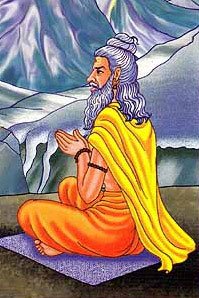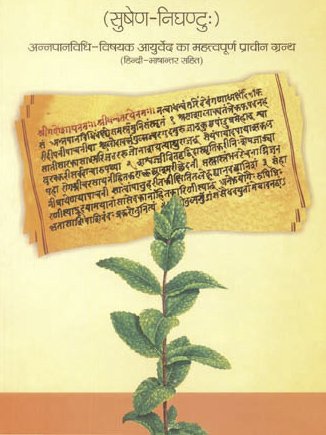Akshiroga, Akṣiroga, Akshi-roga: 6 definitions
Introduction:
Akshiroga means something in Hinduism, Sanskrit. If you want to know the exact meaning, history, etymology or English translation of this term then check out the descriptions on this page. Add your comment or reference to a book if you want to contribute to this summary article.
The Sanskrit term Akṣiroga can be transliterated into English as Aksiroga or Akshiroga, using the IAST transliteration scheme (?).
In Hinduism
Purana and Itihasa (epic history)
Source: Wisdom Library: Viṣṇu-purāṇaAkṣiroga (अक्षिरोग) refers to “ophthalmia” (inflammation of the eye) and represents a type of Ādhyātmika pain of the bodily (śārīra) type, according to the Viṣṇu-purāṇa 6.5.1-6. Accordingly, “the wise man having investigated the three kinds of worldly pain, or mental and bodily affliction and the like, and having acquired true wisdom, and detachment from human objects, obtains final dissolution.”
Ādhyātmika and its subdivisions (e.g., akṣiroga) represents one of the three types of worldly pain (the other two being ādhibhautika and ādhidaivika) and correspond to three kinds of affliction described in the Sāṃkhyakārikā.
The Viṣṇupurāṇa is one of the eighteen Mahāpurāṇas which, according to tradition was composed of over 23,000 metrical verses dating from at least the 1st-millennium BCE. There are six chapters (aṃśas) containing typical puranic literature but the contents primarily revolve around Viṣṇu and his avatars.

The Purana (पुराण, purāṇas) refers to Sanskrit literature preserving ancient India’s vast cultural history, including historical legends, religious ceremonies, various arts and sciences. The eighteen mahapuranas total over 400,000 shlokas (metrical couplets) and date to at least several centuries BCE.
Ayurveda (science of life)
Toxicology (Study and Treatment of poison)
Source: Shodhganga: Kasyapa Samhita—Text on Visha ChikitsaAkṣiroga (अक्षिरोग) refers to “ailments of the eyes”, as described in the Kāśyapa Saṃhitā: an ancient Sanskrit text from the Pāñcarātra tradition dealing with both Tantra and Viṣacikitsā—an important topic from Āyurveda which deals with the study of Toxicology (Viṣavidyā or Sarpavidyā).—The Kaśyapasaṃhita mentions in verse V.62 that the five kinds of wonderful Yantras safeguard all living beings from viral fever, pain, infections, ailments of the stomach, eye (akṣiroga) [kukṣyakṣirogāṃśca] and destroy the myriad kinds of leprosy.
Unclassified Ayurveda definitions
Source: archive.org: Vagbhata’s Ashtanga Hridaya Samhita (first 5 chapters)Akṣiroga (अक्षिरोग) refers to “eye-diseases”, as mentioned in verse 5.36 of the Aṣṭāṅgahṛdayasaṃhitā (Sūtrasthāna) by Vāgbhaṭa.—Accordingly, “[...] (that) [butter] prepared from thickened milk, on the other hand, (is) constipating (and) destructive of hemorrhage and eye-diseases [viz., akṣiroga]. [...]”.

Āyurveda (आयुर्वेद, ayurveda) is a branch of Indian science dealing with medicine, herbalism, taxology, anatomy, surgery, alchemy and related topics. Traditional practice of Āyurveda in ancient India dates back to at least the first millenium BC. Literature is commonly written in Sanskrit using various poetic metres.
Languages of India and abroad
Sanskrit dictionary
Source: Cologne Digital Sanskrit Dictionaries: Cappeller Sanskrit-English DictionaryAkṣiroga (अक्षिरोग).—[masculine] disease of the eyes.
[Sanskrit to German]
Sanskrit, also spelled संस्कृतम् (saṃskṛtam), is an ancient language of India commonly seen as the grandmother of the Indo-European language family (even English!). Closely allied with Prakrit and Pali, Sanskrit is more exhaustive in both grammar and terms and has the most extensive collection of literature in the world, greatly surpassing its sister-languages Greek and Latin.
Kannada-English dictionary
Source: Alar: Kannada-English corpusAkṣirōga (ಅಕ್ಷಿರೋಗ):—[noun] any disease of the eye.
Kannada is a Dravidian language (as opposed to the Indo-European language family) mainly spoken in the southwestern region of India.
See also (Relevant definitions)
Partial matches: Akshi, Roga, Roka.
Starts with: Akshirogajit.
Full-text: Akshishule, Vatu.
Relevant text
Search found 3 books and stories containing Akshiroga, Akṣiroga, Akshi-roga, Akṣi-roga, Aksi-roga, Aksiroga, Akṣirōga; (plurals include: Akshirogas, Akṣirogas, rogas, Aksirogas, Akṣirōgas). You can also click to the full overview containing English textual excerpts. Below are direct links for the most relevant articles:
Charaka Samhita (English translation) (by Shree Gulabkunverba Ayurvedic Society)
Chapter 19 - The Eight Abdominal affections (udara-roga) < [Sutrasthana (Sutra Sthana) — General Principles]
Atharvaveda and Charaka Samhita (by Laxmi Maji)
Treatment of Eye diseases < [Chapter 3 - Diseases and Remedial measures (described in Atharvaveda)]
Elephantology and its Ancient Sanskrit Sources (by Geetha N.)